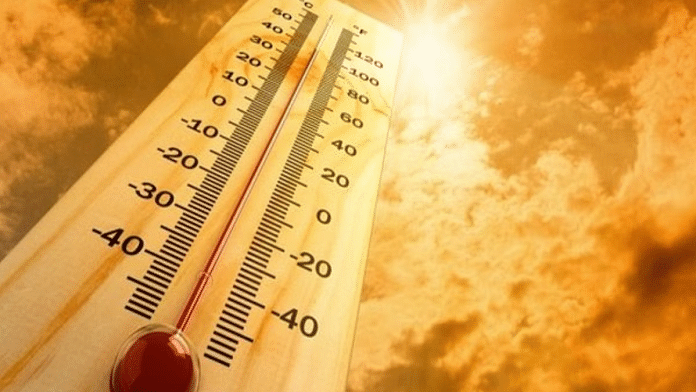New Delhi: With urban heat impacts increasing, Chennai and Surat are experiencing average night time temperatures, which is approximately 3-4 degree Celsius higher than nearby rural areas, while it’s 5 degree Celsius higher for the inland city of Lucknow, a new World Bank report has said.
Heat-related death in India will also rise from 144,000 to 328,500 per year by 2050 under a high-climate change scenario, an increase of 128 percent, the report has estimated, adding that this is in line with historical trends.
Titled ‘Towards Resilient and Prosperous Cities in India’, the report released Tuesday found that intense heat waves and urban heat island (UHI) effects are already causing temperatures in city centers to rise by over 3-4 degrees over surrounding areas.
In Surat, for instance, the report says the number of hot nights is expected to rise from 65 percent of nights per year to 82 percent. “In the most densely built neighborhoods, the frequency of hot nights will be even higher, with nocturnal temperatures rarely falling below 25°C.”
At present, across all three cities—Chennai, Surat and Lucknow, 25 percent of working hours per year meet or exceed the high heat stress threshold.
The report studied 24 Indian cities, with a special focus on Chennai, Indore, New Delhi, Lucknow, Surat and Thiruvananthapuram, and found that “timely adaptation can avert billions of dollars of annual losses from future weather-related shocks.”
It states that cities generally experience higher temperatures compared to surrounding rural areas due to concrete structures, roads, and other impermeable infrastructure.
“These absorb solar energy and re-emit it at night, leading to higher temperatures, a phenomenon called the UHI effect. In Indian cities, UHI is often exacerbated by high population densities, concrete structures, limited green spaces, and increased heat generated by human activities, such as transportation, industry, and air conditioning,” the report states.
It also estimated that exposure to dangerous levels of heat stress has also increased by 71 percent—from 4.3 billion in 1983-1990 to 10.1 billion persons-hour per year—in 2010-2016 in 10 large cities of India. These include Pune, Hyderabad, Surat, Lucknow, Varanasi, Ahmedabad, Chennai, Mumbai, New Delhi and Kolkata.
Also Read: Human body, in the heat of the moment
Even GDP at risk from heat stress
According to the World Bank report, heat-related excess deaths in Chennai, Surat, and Lucknow are already estimated at between 0.2 to 0.4 per 1,000 people annually, with the heat-related excess mortality rate approximately 20 percent higher for people aged 70 or above.
But what should worry Indian policy makers more is the modeling carried out for the World Bank report, which estimates a 30 percent increase in the crude death rate for Chennai and Surat by 2050 under a low-emissions scenario and a 38 percent increase for Lucknow.
Extreme heat is also adversely impacting the city’s GDP. The report mentions that In Chennai, extreme heat is already putting workers in danger and costing as much as $1.9 billion each year, or 2.3 percent of the city’s GDP. “Under a global high-emissions scenario, 3.2 percent of the city’s GDP could be at risk by 2050 because of heat stress,” the report says.
But with over 50 percent of the urban infrastructure required for 2050 still to be built, India has a critical opportunity to drive resilient urban infrastructure development, the report points out.
“The imperative for India to build resilient cities at scale is clear. By investing in more green and resilient urban development—including housing, transport, and municipal services—cities can better mitigate extreme heat conditions and urban floods, and continue to grow and create jobs,” World Bank country director Auguste Tano Kouame said.
The World Bank has recommended that Indian policy makers implement programmes to address extreme urban heat and flooding, including better regulation of stormwater, green spaces, installation of cool roofs, and effective early warning systems.
Besides, India should also invest in resilient infrastructure and municipal services, energy efficient and resilient housing, modernize solid waste management and make urban transport flood resilient.
The World Bank has also batted for engaging the private sector for upgrading the city’s infrastructure. It estimates that investments of over $2.4 trillion will be needed by 2050 to meet the need for new, resilient, and low-carbon infrastructure and services in cities. “The private sector’s role will be critical in meeting these investments,” the report states.
World Bank’s Asmita Tiwari, one of the co-authors said, “Timely interventions will help India’s cities continue to safeguard lives and properties, attract new businesses and jobs, and drive innovation.”
The report cites how several cities are already taking urgent steps to build resilience. For instance, Ahmedabad has developed a Heat Action Plan model, which aims to strengthen early warning systems, improve healthcare readiness, increase green cover and shift work schedules for outdoor laborers.
Kolkata has adopted a city-level flood forecasting and warning system, while Indore has invested in a modern solid waste management system, improving cleanliness and supporting green jobs. Chennai has adopted a climate action plan based on thorough risk assessment and targeting both adaptation and low-carbon growth.
(Edited by Tony Rai)
Also Read: India recorded 67,637 heat stroke cases, 374 deaths between March and 25 July, govt tells Parliament






